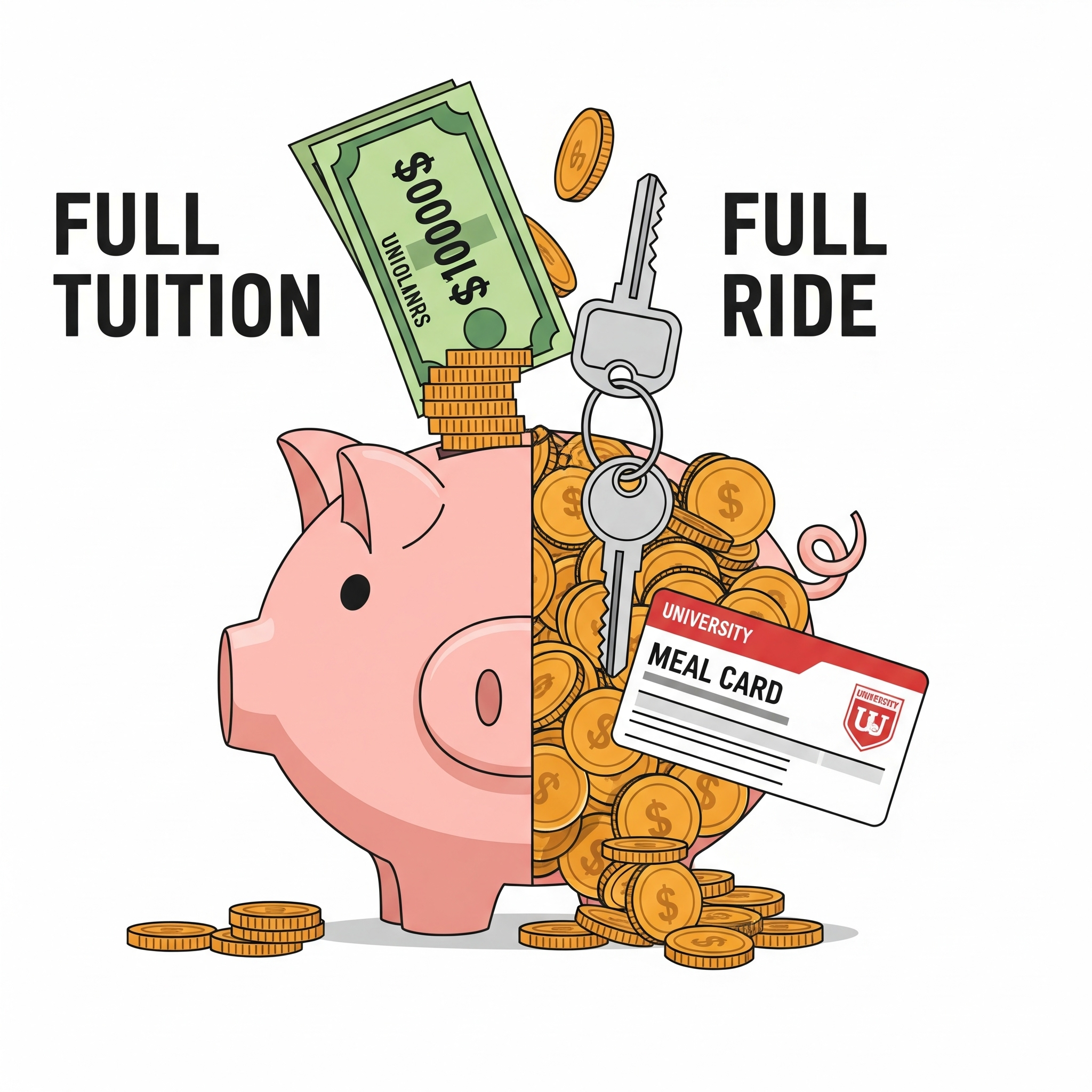← Back to the College Scholarships Hub

- The plain-English difference between full tuition and a true full ride
- Real public-university examples (with links) and why the wording trips families up
- How to tell what’s actually covered before you celebrate
- A quick comparison chart + parent FAQ
When my daughter first started looking at colleges, I thought a “full ride” meant we’d never pay a dime. Housing, food, books, everything — covered. Then I looked closer at one school’s website and realized their so-called “full ride” was actually just tuition. That’s a big difference when room and board can run $12,000–$18,000 a year. If you’ve ever felt confused by these terms, you’re not alone. Here’s the clear, parent-friendly version — with real examples from public universities.
🔎 Quick Difference
Full tuition covers tuition only. Families still pay housing, meals, books, and fees. A full ride covers tuition plus housing and meals (and sometimes extras like study abroad or a laptop).
✅ Full Tuition Scholarships
What it means: Tuition is covered; you’re still on the hook for housing, meal plan, books, and required fees.
Typical value: Roughly $9,000–$20,000 per year depending on in-state vs. out-of-state rates.
Examples:
- University of Arkansas: Some high-achieving students receive awards that effectively cover full tuition. Housing/meals remain out-of-pocket.
- University of South Carolina: Competitive awards can hit the tuition mark; families should still budget for room and board.
Bottom line: Full tuition is excellent—but expect a bill for living expenses.
🏆 Full Ride Scholarships
What it means: Tuition, housing, and meals are covered; some programs add a stipend for books, research, or study abroad.
Typical value: $25,000–$35,000+ per year depending on the university’s full cost of attendance.
Examples:
- University of Alabama: The top-tier package (e.g., Presidential Elite) combines major tuition coverage with housing for the first year and a book allowance—often approaching a practical full ride for many families.
- Florida State University: The Stamps Scholarship is a true full-ride experience with significant extras; extremely competitive.
Bottom line: True full rides are rare and highly competitive (often top 1–2% of applicants).
💬 Why Parents Get Confused
- Fuzzy wording: Some pages casually say “full ride” when they mean “tuition.”
- Housing can exceed tuition: At many publics, room + board rivals—or exceeds—tuition.
- Resident vs. nonresident: “Full tuition” might mean the lower in-state rate; out-of-state families can still see a gap.
🧭 How to Tell What You’re Really Getting
- Read the fine print: Look for exactly what’s covered (tuition alone vs. tuition + housing + meals).
- Compare full COA: Use our college guides. We list tuition, housing, and average net price for each school.
- Email the scholarship office: Ask directly whether housing and fees are included.
📊 Quick Comparison Chart
| Term | Covers | Not Covered | Who Usually Wins |
|---|---|---|---|
| Full Tuition | Tuition only | Housing, meals, books, fees | Strong GPA/test scores (e.g., ~3.7+ and ACT ~28+)* |
| Full Ride | Tuition, housing, meals (often extras) | Sometimes books/personal expenses | Top 1–2% of applicants; competitive selection |
*Cutoffs vary by school and year. Use our pages for school-specific bands and notes.
❓ Parent FAQ
Is a “full tuition” scholarship still worth it?
Yes. At many public universities, covering tuition removes the largest academic cost. Just budget realistically for housing, meals, books, and fees.
How rare are full rides?
Very. They typically go to a tiny fraction of applicants and often require separate applications, interviews, or a campus visit. Treat full rides as a bonus—build a list of schools where your student is likely for strong automatic or near-automatic merit.
How do I find schools where my student qualifies automatically?
Start with our college scholarship guides. We show automatic merit ranges, who typically wins, and whether awards stack with other aid.